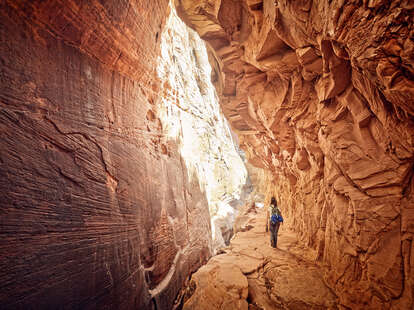Long Lines, Trashed Trails — How National Park Service Layoffs Could Affect Your Trip
Rangers say we can expect bathroom quality to go down, and dangerous wildlife encounters to go up

This Valentine’s Day brought heartbreak for around 1,000 probationary employees of the National Park Service and 3,400 in the United States Forest Service as they were unexpectedly laid off—a majority of whom had been with the services for less than a year. The terminations came as the result of policies set by the new Elon Musk-led Department of Government Efficiency (DOGE) with the goal of cutting federal spending. The timing couldn’t be worse, with an estimated 330,000 people expected to descend on parks across the country during the peak spring and summer travel seasons. With the loss of nearly five percent of NPS’s and 10 percent of USFS’s workforces, what can travelers expect for this year’s trips?
Brian Gibbs, former education park ranger at Iowa’s Effigy Mounds National Monument, who lost his “dream job” due to the layoffs, outlines in a now viral FaceBook post the expansive scope of park rangers’ responsibilities: Educating visiting school groups on wildlife, protecting 2,500 year old Indigenous burial grounds, cleaning toilets and refilling soap dispensers, and opening hiking trails were just some of Gibbs’ duties as a park ranger. That’s not to mention trail maintenance, administering first aid, or preventing dangerous wildlife encounters.
Without proper staffing, then, travelers do need to worry about how park facilities (most importantly, bathrooms) will be maintained. What about hiking trails? Will they all be open? Will the ones that are open be clean or accessible? Will school trips be able to happen, without enough education rangers around to act as guides?
Twenty-four year-old Cole Fournier lost his USFS job as a forest technician in Colorado’s White River National Forest after just about nine months in the role. Fournier worked alongside two other full-time technicians and two summer interns as the eyes and ears of the forest. Together, they worked to put out abandoned campfires, enforce the 14-day limit on camping, clean up trash left by visitors, and help navigate the myriad of complexities around human-wildlife interaction. Now with his former crew down to just two this winter, Fournier warns that visitors to the forests and parks are going to start seeing significant changes. A major concern he has is overcrowding.
“People are going to notice significantly more people overstaying in areas,” he says. “We go in there and manage [22 designated sites] because people don't necessarily know that they're supposed to be out by a certain time. And so if people start realizing this, they could just take up residence and then live there.”
Fournier is also concerned that without rangers around to moderate crowds, visitors will start moving into spaces that are not meant for hiking or camping. In areas that are open to visitors and campers, it is likely that trash will become an issue at the more popular sites. Furthermore, rangers will not be around to prevent visitors from interacting with wildlife or trespassing in blocked-off areas.
“As I'm walking around, I have to tell people, ‘Don't walk into the water,’ ‘don't walk past the barriers,’ ‘don't walk up to moose,’” he says. “We are out there managing the human wildlife interaction by trying to help people realize there's a moose there and say, ‘Maybe you shouldn't go down this trail.’ But with fewer [rangers] out there, that's going to be different.”
What that means, Fournier says, is that vegetation will likely be negatively affected and the number of dangerous interactions with wildlife will rise.
“Without us managing [prohibited campsites], they could easily grow and expand into any areas where there's minimal [human] impact right now,” Fournier explains. “People will start moving into areas that are sensitive and the vegetation is going to see degradation, and that's something that takes a long time to recover.”
Staffing at the NPS and USFS still remains in flux. Last fall, the USFS announced a service-wide hiring freeze while 5,000 seasonal NPS jobs were rescinded last month because of a separate Donald Trump-issue spending freeze. (The NPS has since announced that these jobs will actually be reinstated.) As DOGE continues to enact changes to the NPS and USFS, what exactly a national park vacation will look like going forward is unclear.
“I think the most detrimental part is that we could be managing these resources a lot better, especially for an area that is seeing such growth in visitation,” Fournier says. “Everyone loves national forests and national parks.”